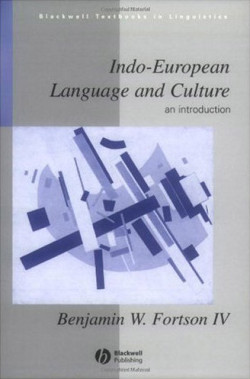Benjamin W. Fortson IV
Blackwell Publishing, 2004, 484 blz.
Ik was in een ander boek aan het lezen, en daar werd gesproken over Indo-Europees, en dat het boek van Benjamin Fortson de moeite waard zou zijn.
Niét gelogen.
Dit is een machtig interessant werk. Zeer grote stukken gingen helemaal over mijn hoofd. Niet omdat het niet duidelijk was of onvolledig, maar zuiver omdat ik het boek gelezen heb als een boek, terwijl het even goed (of beter, eigenlijk) als een cursus gelezen kan worden. Ik vermoed dat mensen die dit moeten studeren op de universiteit niet enorm veel verder moeten zoeken om een uitstekende uitvalsbasis te vinden voor alles wat Indo-Europese taal en cultuur is.
Het begint met het boeiende verhaal van de reconstructie van (proto-)Indo-Europees, de taal, de cultuur, de regio van oorsprong, en gaat dan op alle takken van het Indo-Europees in. Met telkens voldoende informatie om meer dan op weg te zijn, een geannoteerde literatuurlijst, een lijst van termen zeker te onthouden en oefeningen en mogelijke examenvragen.
Ik ben er redelijk gerust in dat als ik dit als handboek had gelezen en er een paar maand over gedaan had in plaats van een paar dagen, ik ernstig veel zou geweten en onthouden hebben over de materie.
Ter illustratie: oefening één van hoofdstuk één:
Memorize the names of all the branches of the IE family, and the names and filiations of the extinct languages in figure 1.1
Een oefening in het midden, over Latijn:
Based on §13.13 and your knowledge of PIE and Latin sound changes, into which of the four conjugations would the following PIE athematic verbs have fallen?
- *bleh1-ti ‘weeps’
- *bheh2-ti ‘speaks’
- *neh1-ti ‘sew’
…en de laatste oefening van het laatste hoofstuk:
Imagine that you are the proud discoverer of a hitherto unknown ancient IE language belonging to a hitherto unknown branch of the family. Your task is to report your discovery to the scholarly world. Describe your language, including at least the following information:
- The date of the texts) you have found and the place of discovery;
- The outcomes of all the PIE sounds — consonants, vowels, and diphthongs – in your language. Include at least two sound changes that are conditioned, ie., that happened only in particular phonetic environments (some of the conditioned sound changes that weve talked about are rhotacism in Latin, umlaut in Germanic, Verners Law, and palatalization. Be sure to specify what the phonetic environments were (beginning of a word, between vowels, before a front vowel, wordfinally, etc. etc.);
- The outcomes of these PIE forms: *ph2tḗr ‘father’, *mātēr ‘mother’, *bhrātēr ‘brother, *su̯esór ‘sister’, *pods, *ped ‘foot’, *mūs– ‘mouse’, *kwel- ’to turn’, *h3erbh- ’transfer’ to another sphere of ownership’, *k̂léu̯os fame, *u̯lkwos ‘wolf’, *̑gheimōn ‘winter’, *sneigwh ‘snow’
- A brief description of the nominal system, including: what cases are preserved; what numbers; what genders; the general fate of athematic and thematic nouns;
- A brief description of the verbal system, including: what tenses are preserved; what numbers; the general fate of athematic and thematic verbs, of the aorist, and of the perfect;
- The paradigm in the singular and 3rd plural of the descendant of *h1es- ‘be’ in the present tense, *bher- ‘carries’ in the present tense, and *u̯oide ‘knows’;
- A sample text in your language of a dozen words, including at least half that have an IE etymology and are different from the ones you give in (3) above;
- Some brief remarks about the culture, mythology, society, etc. of the people that spoke your language.
Serieus. Als ik gelijk vijfentwintig jaar jonger was, ik ging dit meteen studeren.
De tweede helft van het boek, waar de takken van het Indo-Europees apart besproken worden (niet alleen de vroegste vormen maar ook meer recente, trouwens), is trouwens hoofdstuk per hoofdstuk te lezen, en hoofdstuk per hoofdstuk machtig interessant. Met telkens geschiedenis en uitleg over de taal(familie), hoe ze geëvolueerd is uit het Proto-Indo-Europees (in fonologie, morfologie en syntax), met een overzicht van de verschillende talen in de familie (geschiedenis, grammatica, zwaar geannoteerde voorbeelden), en literatuurlijst.
Zeer zeer wijs. En een fijn boek om in huis te hebben qua naslagwerk.

Pingback: Indo-European Linguistics: An Introduction
Pingback: Gelezen: Indo-European Linguistics: An Introduction - Michel Vuijlsteke's weblog — Michel Vuijlsteke's Weblog
Pingback: Gelezen: Historische Grammatica van het Nederlands | Michel Vuijlsteke's weblog